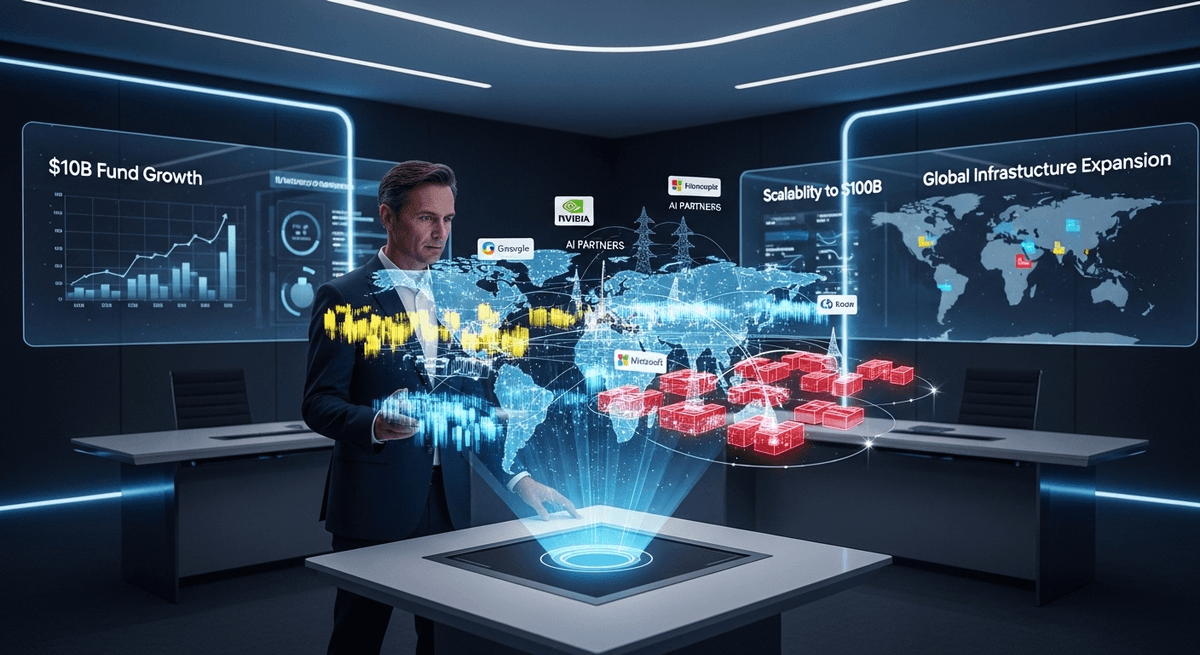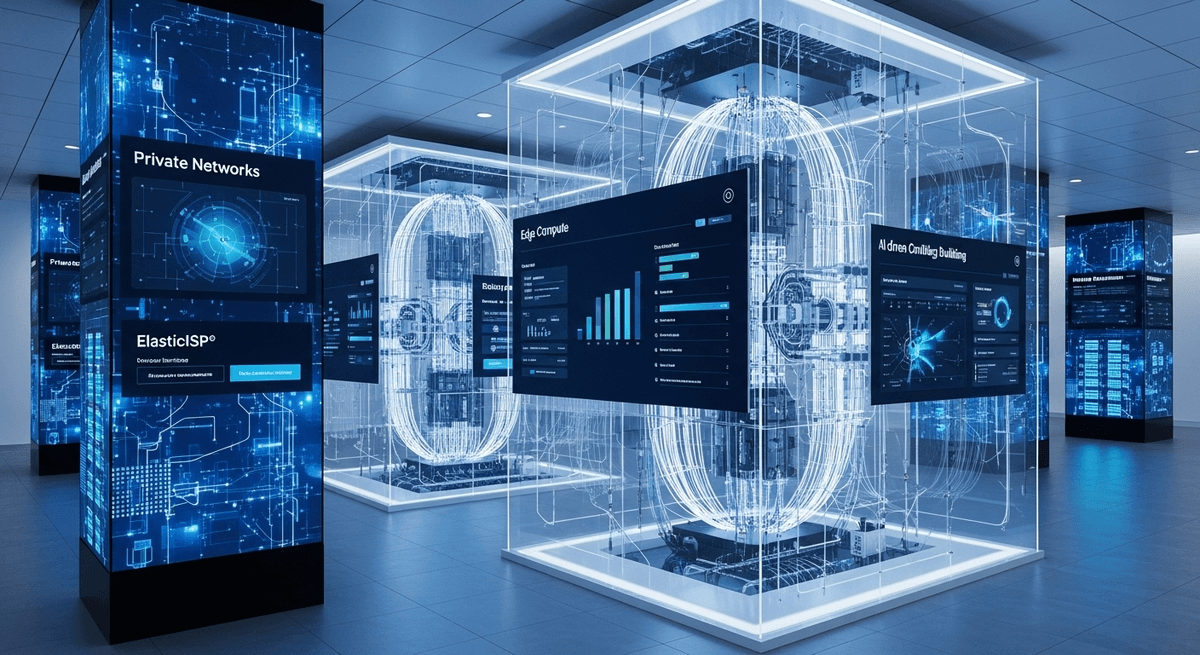Artificial Intelligence is transforming industries at warp speed, but the headlines are missing a deeper story: all this software still needs a home. As models grow, so does the demand for compute, energy, and connectivity. Enter Brookfield Asset Management—one of the world’s largest real estate and infrastructure investors—with a game-changing bet on where AI actually lives.
Brookfield is raising a $10 billion fund, already half-filled by heavyweights like Nvidia and the Kuwait Investment Authority, to develop the infrastructure backbone of the AI era: data centers, power infrastructure, and chip manufacturing campuses [CRE Daily]. Their ambition? Scale to $100 billion and cement themselves as the landlords of the AI economy.
That move isn’t just about physical space. It’s a strategic recognition that whoever owns the physical layer—the pipes, servers, and circuits—owns the future. At OpticWise, we couldn’t agree more.
Why Brookfield’s Move Matters
Most of the AI conversation today revolves around models, applications, and breakthroughs in software. But none of that happens without robust infrastructure.
Brookfield’s AI infrastructure fund focuses on:
- Ground-up development of data centers on raw land
- Power resiliency and generation, often through partnerships (like their $5B deal with Bloom Energy)
- Fiber and interconnectivity for ultra-low latency
- Edge infrastructure in proximity to innovation clusters (e.g., France, Sweden, Texas)
This is long-cycle thinking at its best. They’re not chasing the app of the moment. They’re laying the foundation for everything AI will need to scale.
As Brookfield’s managing partners have put it, they estimate a $7 trillion demand for AI infrastructure globally over the next decade. This includes hyperscale campuses, clean energy generation, and low-latency fiber backbones.

The Strategic Insight: Infrastructure Is Value
For commercial real estate owners, the takeaway is clear: physical infrastructure is no longer just a backdrop—it’s a value engine.
Just like Brookfield is doing at the hyperscale level, building owners have an opportunity to lead locally. By investing in their own digital infrastructure, owners can:
- Monetize connectivity and data services directly
- Increase NOI through premium tech offerings
- Retain operational control and vendor flexibility
- Future-proof assets for AI, ESG, and smart building applications
We call this approach ownership-first infrastructure. And it’s not just for data centers.
Why the Physical Layer Is the Missing Link in Most Portfolios
Let’s face it: too many buildings run on infrastructure that was never designed to support today’s tenant demands. Whether it's multifamily, office, or mixed-use, buildings are often plagued by:
- Vendor-owned networks
- Siloed systems
- Poor connectivity and dead zones
- Zero control over tenant experience data
As AI-driven tools begin to shape not just operations, but tenant expectations (think smart access, predictive maintenance, energy optimization), the risk is this: your infrastructure can become the bottleneck.
At OpticWise, we solve this by helping owners build a resilient, owner-controlled digital backbone that supports:
- ElasticISP®: Private, high-performance, monetizable internet
- BoT® (Building of Things): Integrated operational intelligence
- 5S® User Experience: Seamless Mobility, Security, Stability, Speed, and Service
- PPP 5C™ Framework: Clarify, Connect, Collect, Coordinate, Control
This makes your building not just smarter, but more valuable—a true business intelligence asset.

Brookfield Validates the OpticWise Strategy
Brookfield’s $10B fund is a market signal. It proves that:
- The next generation of value in real estate is digital and physical
- Control over connectivity and energy is essential for future relevance
- Infrastructure ownership is the new location advantage
In essence, Brookfield is playing the infinite game. They’re building assets that outlast hype cycles, software models, and even specific tenants. It’s a long-term strategy with short-term implications.
So what does that mean for owners of non-campus CRE?
It means that if you want to stay relevant in a world where AI shapes everything from leasing to lighting, your infrastructure must evolve. You must reclaim the pipes, the data, and the control.
Follow the Leaders: From Global Funds to Local Impact
Brookfield isn’t alone. Google is investing $40 billion in Texas data center infrastructure. Sovereign wealth funds are backing energy grid improvements for AI reliability. But these moves are macro. What matters now is how CRE owners localize that insight.
Here’s how to do it:
- Conduct a PPP Audit
- Know what infrastructure you own
- Identify where value is leaking
- Understand tenant usage patterns
2.
Deploy Digital Infrastructure Internally
- Install private, owner-controlled networks (ElasticISP®)
- Align building systems via BoT® to reduce friction
3.
Monetize Your Intelligence
- Offer connectivity as a premium amenity
- Use building data to drive leasing, ESG reporting, and CapEx planning
4. Own Your Data and Networks
- Eliminate reliance on third-party ISPs and their contracts
- Keep tenant usage data private and structured for AI-readiness
5. Future-Proof for AI Demand
- Upgrade for latency, uptime, and seamless integration
- Think beyond apps—build for automation, privacy, and scale
AI Will Live Where It’s Supported
Just as Brookfield is positioning itself as AI’s global landlord, local building owners must do the same in their portfolios. Because here’s the truth:
AI doesn’t just need data. It needs a place to live.
If your building can’t support seamless connectivity, edge compute, or data-driven management, it won’t be attractive to AI-native tenants, companies, or technologies.
But if it can? You gain a durable, monetizable edge.
Final Word: Own the Infrastructure, Win the Future
Brookfield’s $10B bet isn’t just a fund—it’s a forecast. It tells us that:
- The biggest opportunities in CRE are infrastructure-led
- Long-cycle investments will dominate short-term trends
- Digital + physical = the new CRE calculus
At OpticWise, we help you operationalize that insight. Our platform delivers the infrastructure, strategy, and user experience you need to:
- Boost NOI
- Protect CapEx
- Enable AI-readiness
- Deliver private, high-speed, branded connectivity
- Future-proof your entire stack
The digital age has landlords. Make sure you’re one of them.
Own your digital infrastructure. Operate with strategic foresight. Build for the long game.
